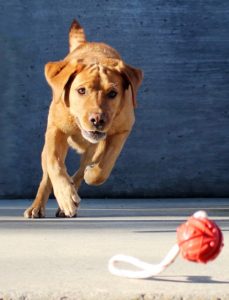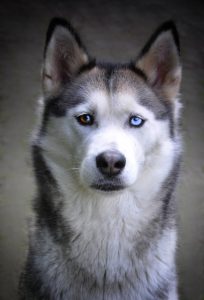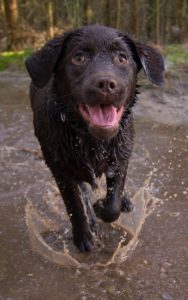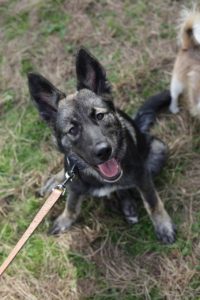Hello dog moms and dads! My name is Bri and I’m a proud owner of an American Bulldog and Pitbull mix named Bruce.
When I decided to adopt a dog, I knew I wanted to bring home a large, loving and loyal animal.
I did some research on dog breeds and the American Bully and Pitbull breeds were exactly what I wanted, so it was a bonus when I found Bruce who is a perfect mix of both!
I have had multiple dogs of different breeds over the years, including Labradors, Huskies, English Mastiffs, and a Shitzu-Bichon mix. Each time we got a new dog, we made sure the breed would fit with our family.
What to Consider When Getting a Dog?
Finding the right breed for you and your family is crucial when bringing home, a new dog.
You’ll need to think about how you will keep the dog occupied, how much energy it has, how big it will get, and many other important needs a dog has.
I’ll go over some of the important factors to consider within the article, whilst we look at Siberian Huskies vs Labradors!
Short Comparison: Siberian Husky vs. Lab
Siberian Huskies and Labradors are both loyal dog breeds that are full of personality.
Since I’ve owned both breeds, I can say personally that they both need a ton of exercise and are some of the most fun dogs to have.
Both breeds are very smart, energetic and love to be in a family environment. They are generally similar in size but have different coats and physical features that make them stand apart.
Each breed is extremely common and can be found pretty much anywhere.
Overview of Huskies
 Siberian Huskies fall under the Working Group and originated from Eastern Asia.
Siberian Huskies fall under the Working Group and originated from Eastern Asia.
They became popular for their ability to run and pull loads for miles across frozen environments and were used during the Alaskan gold rush in the late 1890’s and early 1900’s.
Sibes eventually became a large part of Alaska’s dog racing community which remains popular today.
The American Kennel Club officially recognized the breed in 1930 after the Sibes became popular in Canada.
They are medium sized dogs that usually stay around a max of 60 pounds. These pups are a popular family dog for owners who enjoy an outdoor, high-energy companion.
Overview of Labradors
 Labrador Retrievers are medium to large dogs that fall under the Sporting Group.
Labrador Retrievers are medium to large dogs that fall under the Sporting Group.
They get their name from their uses for hunting and retrieving the game once downed by the hunter.
Labrador lineage dates back as early as the 1700’s in in Newfoundland and where imported to Europe in the early 1800’s.
The exact origin of the breed is unknown but was originally called a St. John’s Dog or Newfoundland dog, and likely comes from a cross between the Greater Newfoundland dog and the French St. Hubert’s dog.
No matter the origin, this breed has become the most popular breed in American homes ranking #1 out of 193 in the American Kennel Club breed popularity count.
As a child, my home had multiple Labrador retrievers over the years. We grew up with this dog breed and each one was a perfect family dog.
Labs are extremely loyal and energetic. They are natural athletes that need a ton of exercise.
Siberian Husky vs Labrador Size: Which is bigger?
Both these breeds are considered medium to large dogs.
However, Sibes tend to stay at a max of 60 pounds while labs, depending on the gender, can get up to 80 pounds.
If you’re looking for a big dog, both are good fits. Sibes tend to look a little bigger because of their fluffy coats.
Siberian Husky vs Labrador Temperament: How do They Behave?
 If you’re looking for a high energy dog, labs are extremely smart and will play a game of fetch all day long.
If you’re looking for a high energy dog, labs are extremely smart and will play a game of fetch all day long.
If they have the scent of something, they can find it anywhere.
Growing up, our lab would bring us a rock or a ball that he wanted us to throw.
We would throw it all the way to the bottom of a huge ravine at my house and into a creek, and he would always find it and bring it right back ready for another round!
Labs easily socialize with other people and dogs and rarely show aggressive behavior.
One hard lesson we learned about lab puppies is that they will chew anything – and I mean ANYTHING.
Shoes, table and chair legs, corners of walls, you name it: they chewed it. This was a result of not keeping the puppy properly occupied with the right exercise and toys; a mistake we didn’t make twice!
Siberian Huskies are very intelligent. Their endurance makes them a perfect dog for adventurers and anyone who enjoys being outside.
As extremely clever dogs, they are also known to be stubborn and mischievous. My former husky named Nala was never afraid to show her personality and vocalize when she wanted to get her way!
That’s a fun trait about huskies though; they love to sing! Their distinctive howls and coos are something they’re very well known for.
Something to be weary of with Siberian Huskies is that they do tend to chase small animals and tend to be aggressive towards dogs they don’t know (living in a very rural area when I had Nala, I had to be careful about her getting too close to the neighbors’ chickens!).
This comes from a protective trait, but they are normally well behaved with dogs that they are properly introduced to. They also LOVE to dig.
Nala was notorious for digging a perfectly round, 8-inch hole to curl up in in our backyard. Not a big deal to us but could be a deal breaker for some homeowners.
Both dog breeds thrive in a family environment and are wonderful with children. However, if your family doesn’t have a lot of time to dedicate to keeping these dogs active, neither one of them would be a good fit.
Siberian Husky vs Labrador Life Span: What’s Their Life Expectancy
Siberian Huskies tend to outlive Labradors. The average lifespan of a Sibe is 12-14 years, while labs are only 10-12.
This can always vary depending on the dog though. My labs typically lived to be 13-14, and the oldest passed away at 15.
Unfortunately, larger dogs are always keener to health complications.
Siberian Husky vs Labrador Health: Are They Prone to Health Conditions
Labradors are overall very healthy. However, there are some problems that should be considered when getting a lab, including exercise induced collapse (EIC) which can occur in young adult Labradors.
Other things lab owners should test for include:
- Hip Evaluation
- Elbow Evaluation
- Ophthalmologist Evaluation
- EIC DNA Test
Siberian Huskies are also relatively healthy dogs. They should also be considered for hip and ophthalmologist evaluations.
With any large dog, bloat can be a life-threatening condition. This is a stomach condition where the stomach suddenly twists and can be deadly to a dog within hours.
Siberian Husky vs Labrador Appearance: What do They Look Like?
 Siberian Huskies are gorgeous dogs with very distinct features.
Siberian Huskies are gorgeous dogs with very distinct features.
A few staple features of this dog are their pointed ears, beautiful facial markings of either black, grey, or tan and white, and a bushy tail that tends to curl.
The most common loved trait about huskies is their striking blue eyes, which are sometimes brown or even one of each.
Labs are also beautiful dogs with folded ears and shiny coats that can come in yellow, black or chocolate colors.
They have a strong tapering tail that propels them through water (and can leave a decent bruise if they’re extra excited!). Their unique facial expressions will melt your heart!
Both dogs have athletic builds and are high endurance dogs. Huskies are prone to pull, that being what their bred for. Labs are born to retrieve, so fetching is their game of choice.
Siberian Husky vs Labrador Shedding: What Kind of Coats do They Have?
Siberian Huskies have a longer, thick coat that was originally developed for working as sled dogs in very cold climates.
Labs have short, dense coats that are perfect for repelling water.
Most dog owners are used to having dog hair, but huskies are literally a whole differed breed when it comes to shedding. I could have made a whole new dog out of the hair I brushed off Nala.
Labradors shed a lot too so there is no lack of dog hair with this breed.
If you suffer from pet allergies, neither dog may be the best choice. Neither of them is particularly hypoallergenic and both produce a lot of pet dander and shedding, making grooming important.
Siberian Husky vs Labrador Grooming: How Much do They Require?
 Both dogs have what is called an undercoat which sheds twice a year.
Both dogs have what is called an undercoat which sheds twice a year.
It’s important for both breeds to be thoroughly brushed during these shedding seasons to remove the old coat.
The great thing about huskies is that they’re self-cleaning, so they don’t need that many baths unless they get into something particularly dirty!
Sibes do need to be monitored for the length of their nails as they tend to grow rather quickly. Both breeds should have their nails trimmed regularly to prevent foot problems.
Labradors on the other hand do need the occasional bath especially after being in a lake, creek or pond (which will be frequent if they’re anything like my labs were).
Siberian Husky vs Labrador Training: Can They be Trained Easily?
Labradors are incredibly easy to train if done properly and at a young age.
We even trained our chocolate lab to ring a strand of bells on the door knob when he needed to go outside. He learned how to let himself in all on his own by jumping up and pushing our door handle down with his paw!
We never could get him to learn to close it, though.
Much like labs, Sibes can be trained without many problems if started young. This breed however tends to be a little more mischievous and stubborn and may require a little more training (and a lot more patience).
Siberian Husky vs Labrador Diet: What do They Eat?
When it comes to feeding these breeds, it’s always important to stick to healthy ingredients.
However, it is pretty common for huskies to thrive on a raw food diet that is plentiful in nutrients and protein for their active lifestyle.
Same goes for labs; they need a healthy, well-balanced diet to keep them going.
Both dogs should usually be fed at least twice a day, but every dog is different, so you should really consult your vet to find out what will work best for your pup.
Siberian Husky vs Labrador Environment: Where Are They Best Suited?
Many people believe that Siberian Huskies are only meant to live in cold climates.
While it’s true that they were built to thrive in that environment, the breed has adapted to be able to live pretty much anywhere.
Labs are also easy going when it comes to the right environment.
Both dogs, however, definitely need plenty of space to run around and get lots of exercise.
A large yard would be perfect for these breeds, but even if you live in a small apartment in the city as long as you find the time to get them moving, they’ll do just fine!
Siberian Husky vs Labrador Running Costs: Are They Expensive to Look After?
Siberian Huskies and Labs are both pretty average when it comes to financial costs.
There are always a lot of added costs to consider when getting a dog, but neither breed is very high maintenance.
Speaking from experience, the most money we spent on both breeds was for food.
Since these breeds are highly active dogs, they exercise a ton and therefore need plenty of nutrition to keep their bodies fuelled. Plus, I don’t want to know how much I spent on toys and treats!
Final Thoughts: Siberian Husky vs Labrador
 While no one dog is better than the other, there are things to consider when choosing the right breed for you and your family.
While no one dog is better than the other, there are things to consider when choosing the right breed for you and your family.
Both Labradors and Siberian Huskies are similar when it comes to their needs and personalities.
If you don’t mind a stubborn dog with lots of playful energy, a Siberian Husky might be perfect for you.
On the other hand, if you love the outdoors and want a loyal, high energy companion, a Labrador could be the better choice.
Having both breeds, I can honestly say that I would choose either one again! Hopefully this helps you make a decision between the two breeds, or you could just get one of each!
Happy pup parenting! If you have any comments or questions, please feel free to leave them below!

